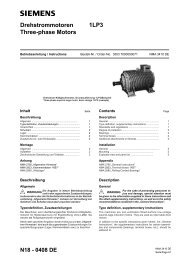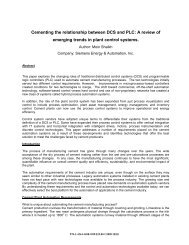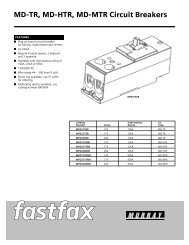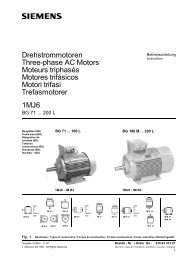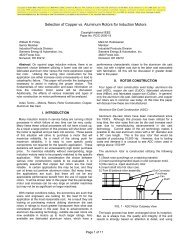WL Circuit Breakers - Siemens
WL Circuit Breakers - Siemens
WL Circuit Breakers - Siemens
Create successful ePaper yourself
Turn your PDF publications into a flip-book with our unique Google optimized e-Paper software.
Communication via Ethernet Interface<br />
<strong>WL</strong> <strong>Circuit</strong> Breaker<br />
In addition to communication via the<br />
serial RS232 channel, the BDA Plus<br />
features an Ethernet interface. If the BDA<br />
Plus is to be addressed via this interface,<br />
it must be integrated in the local<br />
Ethernet (LAN). This chapter explains a<br />
number of key terms and settings.<br />
Ethernet<br />
Unlike PROFIBUS-DP, Ethernet does not<br />
function according to a master-slave<br />
principle. All the stations have equal priority<br />
on the bus, which means that any station<br />
can be the sender and/or receiver.<br />
A sender can only send on the bus if no<br />
other station is sending at that point. This<br />
is due to the fact that the stations are<br />
always “listening in” to find out whether<br />
any messages are being sent to them or<br />
any senders are currently active.<br />
Graphic<br />
5-4<br />
Intranet<br />
Local proxy<br />
Company proxy<br />
Firewall<br />
Local proxy<br />
Gateway<br />
INTERNET<br />
Stations<br />
This diagram illustrates the structure of an Ethernet, how an intranet is integrated,<br />
and how this is connected to the Internet.<br />
<strong>WL</strong> PROFIBUS/MODBUS Communication and Electronic Accessories<br />
If a sender has started sending, it checks<br />
that the message it has sent is not corrupt.<br />
If the message is not corrupt, the send<br />
operation continues. If the sender detects<br />
that its data is corrupt, it must abort the<br />
send operation because a different sender<br />
has already started sending data.<br />
After a random time has elapsed, the sender<br />
restarts the send operation. This is known<br />
as CSMA/CD and, because it is a “random”<br />
access procedure, does not guarantee a<br />
response within a certain time frame. This<br />
largely depends on the bus load, which<br />
means that real-time applications cannot<br />
yet be implemented with Ethernet.<br />
Definition of Key Terms<br />
An Intranet system is comprised of several<br />
Ethernet lines connected to each other via<br />
gateways within a company. The structure<br />
of an Intranet system can be just as diverse<br />
as that of the Internet; it can be restricted to<br />
one location or distributed worldwide.<br />
Stations<br />
Repeater<br />
SECTION 5<br />
Ethernet/Intranet lines are connected to each<br />
other using repeaters, bridges/switches,<br />
routers and gateways. These modules<br />
work at different levels in the ISO/OSI<br />
7-layer model.<br />
The repeater (or star coupler) only<br />
regenerates and strengthens the electrical<br />
signal, it does not interpret bits. The bridge<br />
(or switch) physically separates the networks<br />
and performs fault and load disconnection.<br />
Filtering and guidance mechanisms are<br />
usually implemented. The router decouples<br />
the networks at the logical level (protocol<br />
level) by means of the specified addresses.<br />
Using routing tables, it knows which<br />
messages are to be sent to which address.<br />
It continues to work, however, on a<br />
protocol-dependent basis. The gateway<br />
also enables the router to convert services.<br />
This means that it can act as a security<br />
mechanism, such as a firewall, while<br />
functioning as a proxy.<br />
A proxy is a program in a gateway that acts<br />
as both the server and client. It processes<br />
requests, translates them if necessary, and<br />
forwards them to the addressees. Proxies<br />
are also used to control access (firewall)<br />
and forward requests for protocols that are<br />
not supported. Intranet users in particular<br />
are familiar with the Internet/Intranet page<br />
caching function offered by proxies.<br />
The Intranet is connected to the Internet via<br />
a company proxy, which can also act as a<br />
firewall. If a PC (user) wants to access<br />
an area of the Intranet from the Internet,<br />
the firewall must be informed of which<br />
addresses can be accessed from outside.<br />
5/22




